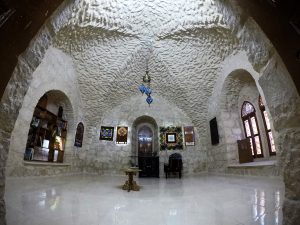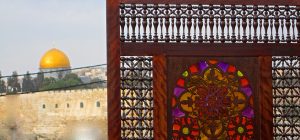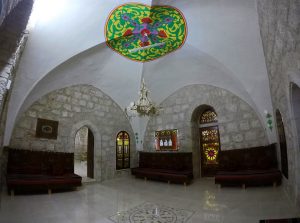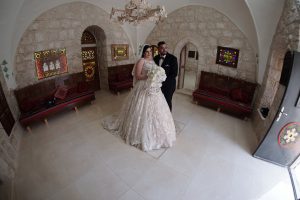By Rami Siam
The “House in Jerusalem,” or the Abu Saud Museum, which belongs to the Arab Jerusalemite author and artist Azzam Abu Saud, is considered a unique place in the Holy City. The house itself was built in the nineteenth century and offers the visitor a panoramic view of Jerusalem and the Old City. The house was built in the fashion of its era, which fuses two different construction models, the older Mamluk and newer Othman styles, which were unique in the manner in which they utilized spiral domes and highly artistic wooden balconies (mashrabiya), which artfully combine intricate woodwork through the use of engraved wood and latticework.
A new, must-see attraction that offers a panorama of the Old City.
The house, with its artistry and history, serves to represent the owner of the house – a multitalented individual in every sense of the word. He is a novelist and playwright, a journalist who has written numerous articles that touch on issues in the spheres of ideology, politics, economy, and the oral history of Jerusalem. He is a collector of Jerusalem’s oral history tales and an artist and artisan who singlehandedly is working on reviving the lost art of Arabesque in Jerusalem. The glory days of this form of artisanship in Palestine are long gone, and one could even say that Arabesque in the Holy City is becoming extinct; though at one time it served to distinguish Jerusalem from all other Arab and Muslim cities during the Umayyad and Fatimid eras. Most of the artwork produced under the banner of Arabesque artwork in Jerusalem was destroyed during two substantial earthquakes that took place at the beginning of both the eighteenth and nineteenth centuries in Jerusalem, and these works are only remembered through the drawings of major international artists who visited the Holy City and drew the features and beauties of Jerusalem using their oils and watercolors long before cameras were invented.
Arabesque is a beautiful art form that used to adorn most of the balconies and windows in the Holy City. It was also widely used in the production of artistic furniture that decorated the living rooms of those who lived in the Old City of Jerusalem. Arabesque fuses intricately carved wood with latticework, which is then decorated with stained glass. Though one can see such examples of highly crafted artwork in cities such as Damascus, Aleppo, and Cairo, the works found in Jerusalem combined with the holiness of the city serve to take it to another level. Arabesque utilizes geometric designs that used to showcase Arab superiority in algebra and mathematics, and blends them with other more natural designs, such as tree leaves and roses, to produce astonishing pieces of wood art that balance the organized chaos of nature with the human person’s attempt to seek meaning and symmetry in life.
Experience the real soul of Jerusalem.
A visit to the Abu Saud House, or “museum,” is a Jerusalem experience not to be missed. The numerous pieces of Arabesque works reflect limitless combinations of colors and expose the true beauty of this dying art form. Its multiple facets are revealed in the various samples of furniture, windows, and wall-mounted pieces that represent consecutive eras in the vivid history of Jerusalem. Visitors also will get the chance to listen to the owner of the house give a detailed explanation of each art piece and what it represents. Mr. Azzam Abu Saud, the creator of this time capsule, is a true Jerusalemite icon in his own right and is more than willing to discuss his work and anything that relates to Jerusalem. He will also share some of the anecdotal stories that form part of Jerusalem’s oral history.
Mr. Abu Saud opens the house to visitors on Friday evenings from 17:00 to 20:00, and serves coffee as he presents his guests with an analytical and historical explanation of each and every fascinating item. For more information or to arrange a visit, please contact Mr. Abu Saud at azzam.abusaud@gmail.com.
Abu Saud House
25 Panorama Street
Ras al-Amoud, Jerusalem






